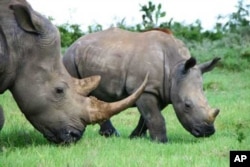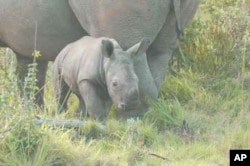In April, conservationist Alan Weyer witnessed a scene he said had continued to haunt him. Summoned to an area of the Kariega Game Reserve in South Africa’s Eastern Cape province, the park’s manager saw a rhino shivering silently in a clearing in the bush.
“This animal had been darted (and sedated), the horn had been removed, but the animal hadn’t died. The animal stood up and it was walking around with, literally, its face hacked off. It was absolutely dreadful,” Weyer said. “We could not save it. A vet had to put the rhino down.”
Just a month before, poachers had targeted another of his rhino. “It’s clear that the animal bled to death because of the hemorrhaging where they cut the horn off,” Weyer explained.
The rhinos killed on Kariega are just two of the almost 450 slaughtered by poachers in 2011in South Africa. “We are incredibly worried at the moment. We are actually facing the worst rhino poaching crisis for decades,” said Lucy Boddam-Whetham, deputy director of the United Kingdom-based organization, Save the Rhino International.
In 2010, 333 of the endangered animals were killed in South Africa. Both 2010 and 2011 were record years in terms of killings in the country. In most cases, the rhinos – members of South Africa’s famous Big Five animals – were tranquillized with veterinary drugs before poachers sawed their horns off.
More expensive than gold
In Asia, rhino horn has been used for centuries in traditional medicines to treat minor ailments such as headaches and fevers. “Commonly it’s ground into a powder and combined with other ingredients to form a medicine that you would swallow like a pill, or it can be ground and mixed into water so that you drink it,” said Tom Milliken of Traffic International, which monitors the world trade in wildlife products.
The Zimbabwe-based director of Traffic’s operations in Southern and Eastern Africa added that demand for rhino horn had boomed in recent years because of a growing belief in parts of Asia, most notably in Vietnam, that it could cure cancer.
“If you’re selling the gift of life, you’re able to ask a premium price and I believe that’s what’s going on,” commented Milliken, who’s traveled across the globe to investigate the increase in poaching in recent years.
According to the International Rhino Foundation, the price of horn is currently nearly $57,000 a kilogram – making it more expensive than gold.
“You lose one rhino, you’ve just lost half a million rand (about $62,500); you lose two, you’ve lost a million rand. Sadly the poachers are selling (horn) for a lot more than that,” said Weyer.
Several studies put the average weight of white rhino horn entering the black market at almost 3.7 kilograms. So criminal syndicates are making huge profits. And they’re reaping these rewards by selling horns that consist just of keratin – the same protein that makes up human hair and fingernails, which science has proven has no curative properties.
On par with drugs and weapons trafficking
But the scientific facts have not permeated the markets for rhino horn in Asia, said Boddam-Whetham, resulting in South Africa becoming the international epicenter of poaching. Its wildlife reserves are home to most of the world’s remaining white and black rhinos – about 20,000 animals.
The World Wide Fund for Nature said poachers killed more than 1,000 rhinos in South Africa in the past four years. “It’s a really sudden increase in rhino killings,” said Boddam-Whetham. “If you look back to 2007, there were only 13 lost. So you can see the massive jump…. I think it’s been a massive shock to everyone – the level of poaching at the moment.”
“Certainly not the least reason for the sudden spike is that rhino poaching has now become part of international organized crime, on the same level – in terms of execution, sophistication and ruthlessness – as drug and weapons trafficking, said Kirsty Brebner, director of the Rhino Security Project at South Africa’s Endangered Wildlife Trust.
Despite this, she said, governments and law enforcers have not invested enough resources in anti-poaching operations and the smuggling of illegal wildlife products.
“This opened the door for organized crime. Rhino poaching is an easy avenue to riches,” Brebner said. “Some of the organized crime syndicates are seeing it as an easy option, to move away from their traditional drugs and explosives and guns and so on. It’s a low risk, high reward type of operation….”
Asian economic success fuels poaching
Another factor in the upsurge of rhino poaching, according to many in the wildlife industry, is the Asian economic boom of recent years. “Suddenly, with more disposable income than ever before (in Asia), rhino horn has made a huge resurgence on the local market,” Milliken stated.
He said this is particularly true of Vietnam, which is now one of the world’s fastest growing economies on the back of its oil, mining, manufacturing and agricultural industries.
“In Vietnam it’s at the point now where they’re selling horn for home use,” said Milliken. “There’s a whole subsidiary industry that is manufacturing these rhino horn grinding bowls, so that you can grind the powder at home and then add water to it and drink it. This is a usage that I’ve never seen anywhere in the world except in Vietnam.”
Boddam-Whetham explained, “More Asians are now able to afford expensive rhino horn products and also the increasing Asian footprint in Africa has opened up trade routes to get rhino horn out of Africa and into Asia.”
The cancer factor
Brebner said the myth that rhino horn could cure cancer was undoubtedly the biggest driver of poaching. Milliken agreed: “This has stimulated usage (of horn) in a way that we haven’t seen before.”
Many in the global wildlife sector attribute the surge in rhino killings to supposed claims a few years ago by Asian politicians and celebrities that the horn cured their life-threatening cancer.
“There was a Vietnamese diplomat or MP that came out a couple of years ago saying that rhino horn had cured his cancer. This has led to a big interest in rhino horn and demand for it,” said Boddam-Whetham.
South African conservationist and game park owner Dale Howarth insisted that soaring demand for horn stemmed from “a Korean national minister who publicized that he’d been cured from cancer from taking rhino horn.”
Milliken said such stories were commonly told in Asia and spread around the world. “Everybody’s heard it. They’ve heard it so much that there’s kind of a tacit belief that maybe it happened, but we can’t actually validate any of these stories. When you really go for the details to get a name and to put a face on this, you can’t get there,” he maintained.
Milliken described the cancer cure legends as urban myths that are brilliant marketing tools invented and spread by criminals to boost demand, and thus prices, for rhino horn.
He said killings have increased massively as the poaching syndicates have been driven to kill as many rhino as fast as possible because they know that the rhino horn market is a “bubble economy that will burst” relatively soon.
“Obviously people who take rhino horn and have cancer are not going to be cured in the long run. So I think that there’s a race against time here (and) that the criminal syndicates are maximizing their profits while they can.”
Milliken remained concerned that the bubble would not have burst before the “large-scale entry of China into the illegal rhino horn trade.
“China looms large in the background. We’re increasingly worried about the market for rhino horn in that country,” he said. “With the largest number of consumers in the world, any resurgent rhino horn trade in China is going to have major consequences around the world.”
Back on South Africa’s wildlife reserves, conservationists and anti-poaching units continue their efforts to save the country’s rhinos. It’s a battle that many acknowledge they lost in 2011. It’s also a battle that’s transforming as it intensifies.
“It’s now a war, plain and simple,” said park manager Alan Weyer.












